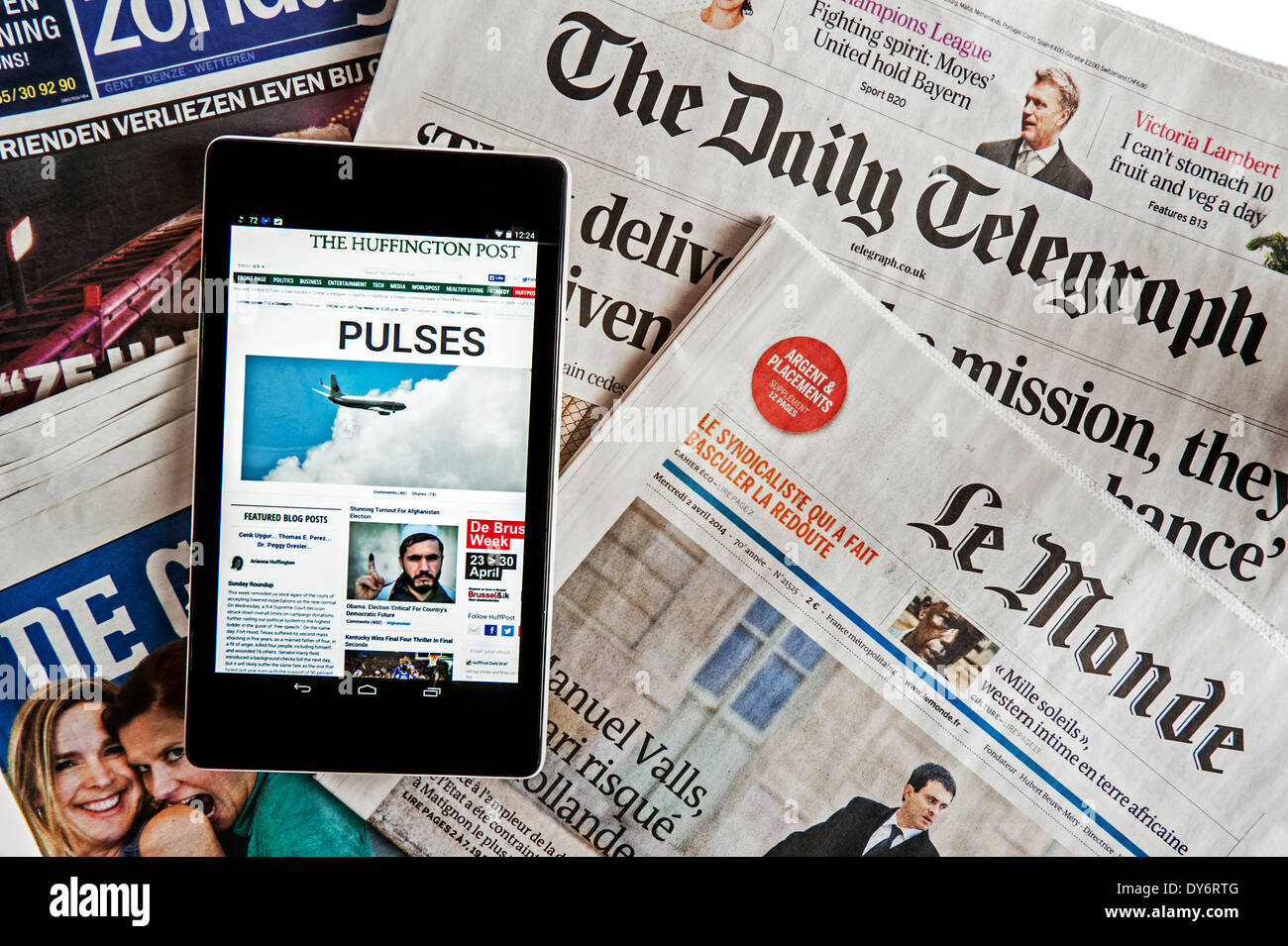The Impact of Social Network heading We Consume News Online
Social media site has essentially changed news usage. It supplies prompt access to details, usually overshadowing typical media outlets. Nevertheless, this quick circulation includes challenges. Individuals deal with the threat of experiencing misinformation and ending up being entraped in resemble chambers. The formulas driving tailored web content can obscure diverse point of views. As these dynamics advance, understanding their ramifications ends up being essential for notified interaction in public discussion. What strategies might aid browse this facility landscape?
The Advancement of News Usage in the Digital Age
As technology advanced, the means individuals eaten news transformed significantly in the electronic age (stnews.live). Traditional newspapers and relayed media began to decline as the net became a key resource of details. On-line platforms used instant access to newspaper article, videos, and podcasts, allowing customers to remain notified at any moment. The ease of mobile phones additionally accelerated this change, making it possible for users to receive updates on the move
In addition, the rise of news collectors and websites assisted in the consumption of varied perspectives, empowering customers to customize their news intake based upon personal interests. This advancement likewise triggered wire service to adapt their strategies, concentrating on electronic content and interesting readers through multimedia layouts. As a result, the standard barriers of time and space in news distribution decreased, causing an extra instant and personalized news experience for audiences worldwide.
The Role of Social Media Site Platforms in News Circulation
Social media site platforms have actually changed news distribution by giving instantaneous access to information. Their algorithm-driven material curation typically focuses on involvement over accuracy, bring about substantial credibility obstacles (stnews.live). As users browse this landscape, the effects for news usage and public discussion come to be increasingly intricate
Immediate News Access
Standard news outlets have long been the key resource of information, the rise of social media systems has dramatically changed how news is accessed and eaten. Instant news gain access to has actually become a trademark of the electronic age, making it possible for users to obtain updates in real time. Platforms such as Twitter, Facebook, and Instagram allow news to spread quickly, typically exceeding traditional media in rate and reach. Users can share stories, remark on occasions, and engage with reporters, developing a dynamic communication in between the audience and news web content. This immediacy promotes a society of necessity, triggering individuals to inquire rapidly. Consequently, the expectation for prompt news has actually reshaped journalistic techniques, compelling news organizations to adapt their approaches to meet the needs of a hectic electronic atmosphere.
Algorithm-Driven Content
While individuals proactively involve with material on social media, the algorithms that govern these platforms play a crucial role in figuring out which news stories acquire visibility. These algorithms analyze individual actions, preferences, and involvement metrics to curate personalized news feeds. Therefore, particular stories may be intensified while others continue to be rare, often prioritizing marvelous or trending subjects over substantive reporting. This discerning exposure forms users' understandings of present events and affects public discussion. Additionally, the reliance on algorithm-driven web content can develop resemble chambers, where customers are primarily exposed to perspectives that line up with their very own ideas. The characteristics of news distribution on social media platforms greatly affect how people consume and analyze info in the electronic age.
Reputation Obstacles
As users progressively turn to social media for news, the trustworthiness of information experienced on these platforms ends up being a pushing problem. The decentralized nature of social networks allows anybody to release web content, frequently blurring the lines between trustworthy journalism and false information. Formulas focus on involvement over precision, leading to the extensive dissemination of astonishing or deceptive tales. This atmosphere presents significant obstacles for individuals trying to determine trustworthy resources. Social media site systems, while striving to combat false information with fact-checking and web content small amounts, run the gauntlet for incongruities and prejudices in their techniques. Inevitably, the obligation lies with individuals to seriously examine the news they consume, as the rapid spread of details often surpasses verification efforts by platforms.
The Rise of Resident Journalism and User-Generated Material
The rise of citizen journalism has actually equipped everyday people to share news and perspectives, typically giving understandings that conventional media may forget. However, this shift additionally provides considerable difficulties, especially the spread of false information that can occur from unverified web content. As user-generated content becomes a lot more common, the equilibrium between authentic voices and accuracy in reporting remains an essential worry.
Equipping Daily Voices

Difficulties of Misinformation
While the rise of person journalism has opened up opportunities for varied voices in the media landscape, it has likewise introduced significant difficulties connected to misinformation. The simplicity of sharing information via social media platforms enables people to share news promptly, yet this rapid spread usually comes at the price of accuracy. User-generated material frequently lacks the rigorous fact-checking and content oversight that traditional journalism supplies. As a result, sensationalized or false stories can gain traction, misinforming target markets and forming public perception (stnews.live). The mixing of opinion and reality within social media complicates the distinction in between qualified information and false information. Consequently, consumers must navigate a significantly complicated media environment, calling for essential assuming skills to recognize trusted news resources in the middle of the noise

False information and Its Effects for Public Discourse
As social media platforms increasingly control the landscape of information circulation, the proliferation of false information positions considerable challenges for public discourse. Misinformation, typically created to misguide or prompt psychological responses, can misshape perceptions of truth and weaken count on trustworthy resources. This sensation results in polarized point of views, as individuals gravitate towards echo chambers that enhance their ideas, better setting divisions within society.
The ramifications for public discourse are profound. When residents rely upon false information, meaningful dialogue diminishes, and the democratic process endures. Moreover, misinformation can provoke concern and confusion, affecting public health and wellness, safety, and political stability. As a result, promoting media proficiency ends up being vital, encouraging people to critically evaluate information and recognize fact from fiction. Dealing with the difficulties posed by false information is critical for maintaining the stability of public discourse and ensuring an educated people qualified of taking part in useful discussions.
The Impact of Formulas on News Presence
Offered the central role of formulas in figuring out material presence, their influence on news consumption is profound. These algorithms, used by social media platforms, focus on certain kinds of material based upon customer interaction and preferences. Therefore, news articles that align with popular fads or audience rate of interests are more most likely to be shown prominently, while less astonishing tales may be neglected. This produces a setting where customers are revealed largely to info that reinforces the original source their point of views, potentially bring about resemble chambers.
Furthermore, the constant evolution of formulas means that news organizations should adapt their methods to straighten with these changing parameters, frequently prioritizing clickbait or psychologically billed headlines. Consequently, the honesty of news coverage can be compromised, as critical stories might not get the exposure they deserve. The mathematical shaping of news visibility therefore plays a vital function in affecting public assumption and understanding of current occasions.
The Shift Toward Aesthetic Storytelling in News Media
Progressively, news media is welcoming visual narration as a powerful device to involve target markets. This approach leverages photos, video clips, infographics, and interactive elements to communicate info much more effectively than typical text-based formats. As attention covers reduce, visuals offer a quick, impactful method to connect complex stories and grab customers' interest.
Systems like Instagram and TikTok have more accelerated this pattern, engaging wire service to adjust their material techniques to fit these visually-driven environments. By including compelling visuals, news electrical outlets can improve psychological connections and foster better understanding of topical concerns.
Visual storytelling permits for even more diverse stories, showcasing numerous viewpoints with dynamic presentations. As audiences progressively eat news through mobile phones, the shift toward visuals not only satisfies user choices yet likewise aids to break down obstacles to details access. Eventually, this evolution shows a broader makeover in just how news is produced and consumed in the digital age.
Future Patterns: Navigating the Altering Landscape of News Consumption
While the digital landscape remains to develop, news intake is poised for considerable transformation driven by arising innovations and altering audience behaviors. As synthetic intelligence and machine knowing advancement, customized news feeds will certainly end up being much more common, allowing users to receive material tailored to their passions. This customization could result in better engagement however additionally raise worries regarding resemble chambers and false information.
The rise of voice-activated gadgets and smart audio speakers will certainly influence how news is provided, changing the focus from aesthetic to acoustic layouts. This trend might urge news companies to adopt more succinct and engaging audio content.

Regularly Asked Questions
Exactly How Do Social Media Site Communications Affect News Reputation?
Social network communications can considerably affect perceptions of news credibility. Involvement metrics, such as likes and shares, commonly shape target market trust, with popular posts gaining perceived legitimacy, despite the precision or dependability of the details presented.
What Duty Do Influencers Play in Shaping News Narratives?
Influencers greatly form news stories by leveraging their systems to intensify particular tales, frequently customizing content to their audience. This can bring about biased perspectives, impacting public perception and focusing on sensationalism over factual look at this now coverage.
Just How Can Users Identify Reliable News Resources on Social Network?
Customers can determine dependable news resources on social media sites by examining the source's integrity, confirming realities via multiple outlets, examining the professionalism of the content, and recognizing possible predispositions in reporting to assure exact info.
What Effect Does Social Media Site Carry Conventional Journalism Jobs?
Social media greatly affects typical journalism work by changing revenue models, reducing need for print media, and fostering competition from person reporters. Subsequently, several professionals face task insecurity and have to adjust to swiftly transforming media landscapes.
How Do Different Demographics Consume News on Social Network?
Various demographics display varied choices for news intake on social media. More youthful audiences prefer systems like TikTok and Instagram for fast updates, while older people tend to like Facebook and Twitter for much more thorough discussions and articles.